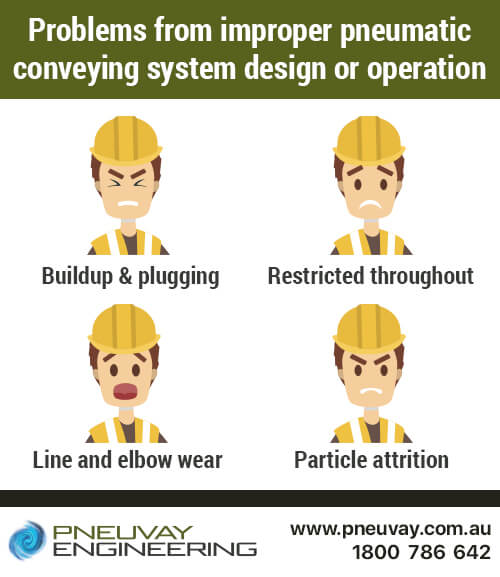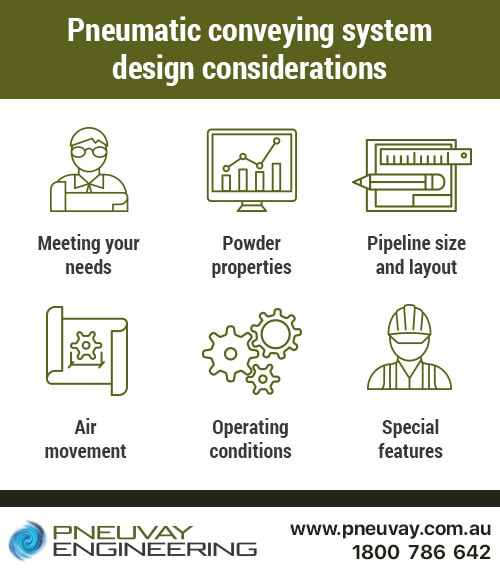Problems from improper pneumatic conveying system design or operation
Proven approach to pneumatic conveying system design
The determination of several pneumatic conveying characteristics are needed when designing a best-fit solution for a new system or optimising an existing system. These pneumatic conveying characteristics include:
- Minimum and optimal conveying air flow rates
- Optimal pipeline diameters
- Solids to air ratio along the pipeline
- Pressure gradient along the pipeline
These characteristics provide most of the information required to develop an optimal pneumatic conveying system design that:
- Minimises energy use
- Minimises pipeline wear
- Utilises optimal feeding and receiving mechanisms
- Utilises optimal air-particle separation systems
Know your bulk material pneumatic conveying characteristics
The key to avoiding pneumatic conveying system design problems is to know the conveying characteristics of the bulk materials to be transported. These are largely dependent on the size, distribution and density of the conveyed bulk material. It is vital to know how the powder or granular material will behave when pneumatic conveyed. This will allow for accurate determination of conveying mode (dense or lean phase), air flow, and air mover type (fan, blower or compressor) to be used within the system.
Bulk materials that have a low melting point can be vulnerable to streamers, snakeskins, angel hair and fluff. Streamers and snakeskins are long, ribbon-like particles formed by frictional heat through extended contact with smooth internal surfaces such as a long sweeping bend. Angel hair and fluff are hair-like particles formed by frictional heat through brief contact with internal surfaces.
A number of operating parameters are determined from these bulk material characteristics. One such parameter is the minimum transport speed required to lift and convey the bulk material. This speed depends on bulk material characteristics such as density, bulk density and flow mode. These are determined with testing on:
- Fluidisation and permeability
- Air-retention and deaeration
- Vertical and horizontal minimum transport.
Understand the pneumatic conveying system requirements
There are several requirements of a pneumatic conveying system that need to be understood when designing a best-fit solution.
Meeting your needs
In general, to meet your needs requires design of a pneumatic conveying system within a processing plant for delivery to a specific:
- Capacity rate of system
- Distance to be transport
Powder properties
The powder or granular material conveying characteristics are necessary to determine the conveying mode to be used. Lean phase systems are dominated by characteristics such as lift, drag and particle collisions. Dense phase systems are dominated by air particle interactions characteristics that are much more complex than in lean systems.
Operating conditions
Various constraints and parameters need to be calculated and verified as acceptable, including:
- Air speeds and capacity rates
- Pressure drops and energy losses
- Ratio of solids to air within system
Pipeline size and layout
How the pneumatic conveying system will fit with minimal length into the processing plant needs to be determined. Wear minimisation and maintenance requirements for pipeline and bends need to be checked against what impact is expected from the air flow rates of the transported bulk materials. These factors need to be balanced to determine the pipeline layout and diameters, including:
- Minimum acceleration zone lengths
- Type of elbows and sweeps in pipeline
- Components such as diverters
- Replacement times for pipeline and components
Air movement
Determination of the air flow rates required throughout the pneumatic conveying system will allow for the optimal specification of any required fans, blowers, or compressors.
Special features
Determine if specialised components are required to prevent or reduce the impact of effects such as:
- Abrasive pipeline wear
- Particle attrition, dust and fines
- Material accumulation and build up
- Streamers, snakeskins and angel hair
Delivering pneumatic conveying system design results
Using our combination of industrial experience and best practice to a thoroughly investigate our specific set of requirements has proven to deliver superior pneumatic conveying system design and avoid major problems.
Proven approach to pneumatic conveying system design
Contact us for assistance on pneumatic conveying system design
Pneuvay is a leading provider of pneumatic conveying system design. We have a focus on food processing plants, cover the Asia-Pacific and Middle East regions, and are expanding into the Australian industry. We service many large food producers and provide best fit and turnkey solutions for food processing plants looking to:
- Install new powder material systems
- Expand production capacity;
- Upgrade existing powder material systems
If you have any questions in relation to powder material systems for a specific food processing, feel free to call on
1300721458 or
contact us.



